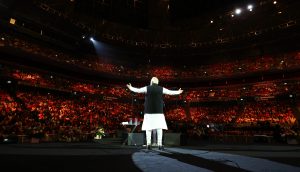The state election results in India have given a head start to the ruling Bharatiya Janata Party (BJP) and Prime Minister Narendra Modi for the parliamentary election due in early 2024.
The legislative elections in five states – Rajasthan, Madhya Pradesh, Chhattisgarh, Telangana, and Mizoram – were the last set of polls before the general election scheduled for April 2024.
While the results of state elections do not always match national elections, their outcome nevertheless has a psychological impact on political parties and voters.
The BJP has won three of these states in Hindi-speaking north India.
This has enabled Modi to assert that the BJP’s “hat-trick” — winning three state elections — implies “a hat-trick in 2024” as well when he seeks a third term in office.
In Telangana, the only southern Indian state that went to the polls, Congress recorded a handsome victory. The results of the south Indian states have been different from that of the north for a long time. Voters in south India are suspicious of the BJP’s attempts to impose Hindi language on them, to the detriment of their local languages. They also do not idolize Modi or buy into the Hindu majoritarian ideology, as yet.
A new political outfit, the Zoram Peoples’ Front (ZPF), has debuted in the northeastern state of Mizoram.
It is in north Indian states, however, that the Congress faces a direct, head-to-head contest with the BJP.
Before the state elections, political observers were keen to see whether Modi’s electoral magic — a mix of demagoguery and ideological rhetoric — was intact. As it turns out, it was.
The ingredients of his recipe for electoral success seem to be: projecting himself over regional party leaders, Hindu majoritarian rhetoric, “Modi guarantees” for increased largesse to the poor and the marginalized, like tribals and women, and a well-oiled election machinery.
In addition to projecting his persona over that of the state-level leaders in the campaign, he made sitting MPs and BJP’s central party leaders contest from constituencies that the BJP had lost in the previous election, in 2018. This compelled them to fight keenly for political survival. Leaving the field open for the chief minister’s job also successfully subdued factionalism.
Modi’s promise of welfare added to the central government’s existing welfare schemes. The free food distribution scheme for the poor introduced during the pandemic has been extended to 2028. In effect, his welfarism simply came across as more credible than the welfare schemes offered by the opposition.
The Congress party’s promise of a caste census, which would guide the distribution of entitlements in proportion to a caste’s size in the population, failed to get traction.
These elections also underlined the contrasting election strategies of the BJP and Congress.
The BJP chose its candidates by a process of internal selection monitored by Modi and Home Minister Amit Shah.
Congress, on the other hand, largely outsourced its surveys for selecting candidates to psephologists and election consultants instead of relying on inputs from block, district, and state level leaders of the party.
The Congress party also seriously underestimated the anti-incumbency sentiment against its state governments in Rajasthan and Chhattisgarh.
In Rajasthan, its two-term chief minister Ashok Gehlot insisted on fielding nearly 90 percent of his outgoing legislators despite their palpable unpopularity, defying the central leadership.
Chhattisgarh has a predominantly tribal population, and the BJP campaign to portray Congress’ state leadership as anti-tribal was successful in rural areas.
Factionalism within the state Congress units in all the three north Indian states significantly hurt its campaign.
Just as the state elections have further entrenched the belief in Modi’s electoral magic, they have also tested the leadership of Rahul Gandhi, the scion of the Gandhi dynasty that controls the Congress party. His main platform opposing the BJP’s “divisive politics” seems to have failed to persuade the majority of the voters.
The defeat of Congress will once again raise doubts about Rahul Gandhi’s ability to lead the party to electoral success in 2024.
With its shrinking national footprint, Congress will find it harder to retain its pivotal position in the opposition’s INDIA (Indian National Developmental Inclusive Alliance) bloc. Regional parties in the bloc are already elbowing for greater space.
The game for 2024, however, is not yet over.
The BJP’s victory in north India is in those states where it already has all or most of the parliamentary seats. Its margin for improving its tally in these states in 2024 is, therefore, limited.
Also, unlike state elections where local issues take precedence, for the national parliamentary election, the BJP will need a pan-India narrative that can sway voters.
India’s “surgical airstrikes” against Pakistan, accused of terrorism against India, provided that narrative in the 2019 general election. There is no such emotional story to tell as yet for 2024.
While its absence from south India remains a formidable challenge, as of now, the BJP and Modi remain ahead in the battle of perceptions.
Originally published under Creative Commons by 360info™.

































